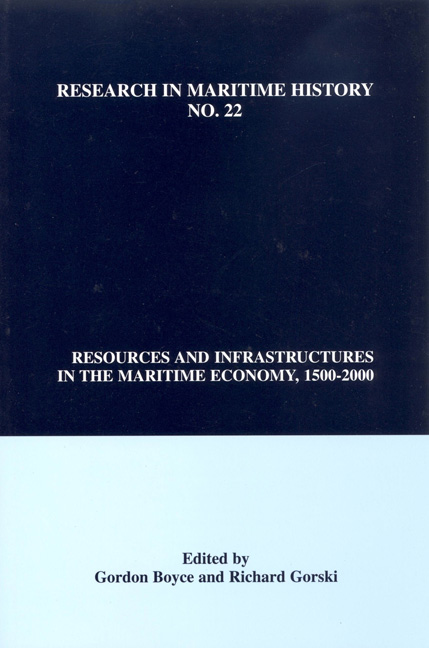Book contents
- Frontmatter
- Contents
- Contributors' Notes
- “Introduction: Resource Flows and Maritime Infrastructures”
- Part 1 Intangible Infrastructures and their Components
- Part 2 Resource Flows and Economic Development
- “Resources and Infrastructures in the Danish Maritime Economy: Evidence for the Coastal Zone, 1500-2000”
- “Resources and Infrastructures in the Maritime Economy of Southwest Scotland, 1750-1850”
- “Fishing Rights in the Postwar Period: The Case of North Sea Herring”
- Part 3 Physical Infrastructures: Port Development and Planning
“Resources and Infrastructures in the Maritime Economy of Southwest Scotland, 1750-1850”
from Part 2 - Resource Flows and Economic Development
- Frontmatter
- Contents
- Contributors' Notes
- “Introduction: Resource Flows and Maritime Infrastructures”
- Part 1 Intangible Infrastructures and their Components
- Part 2 Resource Flows and Economic Development
- “Resources and Infrastructures in the Danish Maritime Economy: Evidence for the Coastal Zone, 1500-2000”
- “Resources and Infrastructures in the Maritime Economy of Southwest Scotland, 1750-1850”
- “Fishing Rights in the Postwar Period: The Case of North Sea Herring”
- Part 3 Physical Infrastructures: Port Development and Planning
Summary
This essay examines the relationship between the maritime sector and economic development in rural southwest Scotland between 1750 and 1850, with particular attention to the link between local economic revival and expansion and the development of its maritime infrastructure. Comprising the counties of Wigtownshire in the west, Dumfriesshire in the east and the stewartry of Kirkcudbrightshire at the centre, Dumfries and Galloway forms the southwest corner of Scotland, covers 2828 square miles and is bounded on the west and south by a 300-mile coastline (see figures 1 and 2). The region is characterised by low population density centred in small villages and hamlets along the coastal lowlands which, even today, tend to be bypassed by arterial roads. Few towns developed, and those that did were either ports or fishing communities at the head of the main estuaries and inlets. Under Article 5 of the 1707 Act of Union, Dumfries (now the administrative capital of southwest Scotland), Wigtown and Stranraer became ports of registry and Kirkcudbright a designated outport of Dumfries. This Act not only united Scotland and England but also extended English registry law to Scottish shipping and admitted Scottish vessels to the privileges of English trade.
By the start of the eighteenth century the region had been reduced to one of Scotland's most impoverished and debt-ridden areas, bereft of the capacity to trade following decades of civil and religious tensions and conflict with the crown. Religious tolerance and political stability subsequently brought security for individuals at a time of great interest in reform in agricultural circles, and in the decades associated with the “industrial revolution” the region began to rebuild its economy. Under the patronage of dedicated innovators, farmers increased the quality of pasture, range of produce, acreage under cultivation and yield. New strains of livestock and forms of animal husbandry were introduced and by 1812 Dumfries and Galloway had well-developed mercantile and professional sectors and was an acknowledged leader within Scotland in the commercialisation of agriculture.
These developments stimulated ancillary industries, such as brewing and tanning, and some significant local woollen and cotton textile manufacturing, all of which enjoyed periods of prosperity between 1770 and 1850.
- Type
- Chapter
- Information
- Publisher: Liverpool University PressPrint publication year: 2002



